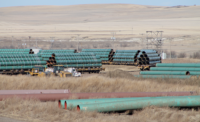The market for designing and building oil- and natural gas-related projects around the world did not collapse in 2009 as some had feared. But neither did the market expand. While many construction-industry firms working in the petrolem sector experienced booms through most of the past decade, the pace of new-contract signing slowed significantly in late 2008 and the first half of 2009 as economies around the world staggered and oil and gas prices tumbled.

Things are looking a little bit better for 2010. In mid-November, Bank of America/Merrill Lynch said it expected global gross domestic product to increase by 4.3% in 2010 and by 4.5% in 2011, following a decline of 0.8% in 2009. It also expects crude oil prices to average $85/barrel in 2010, possibly topping $100/barrel by early 2011.
The brightening forecast for 2010 already is leading some major energy companies to increase their capital spending plans. In November, Suncor Energy said that it soon will resume work on its Firebag Stage 3 in-situ oil sands expansion in Alberta, which was about half finished when Suncor suspended activity on it in early 2009. Suncor has included $900 million for the project in its 2010 capital spending plan. ExxonMobil and Chevron also are expected to slightly increase their 2010 capital spending. International engineering and construction firms with oil-and-gas expertise are starting to benefit from this loosening of capital.
This fall, Milan-based Saipem won three major offshore drilling contracts valued at more than $660 million, including a 36-month extension of an existing deal with Statoil for work in the Norwegian part of the North Sea, a new six-month deal with Total for work in the waters off the United Arab Emirates and a contract from a unit of Royal Dutch Shell for subsea development of oil fields off the coast of Nigeria.
In November, ENI awarded Saipem a 20-year, $1.5-billion contract to supply and operate a floating production, storage and off-loading vessel. For the first eight years, the vessel will be deployed in the Adriatic Sea; its location in the following 12 years will be determined later.
Similarly, Paris-based Technip has won several major jobs in recent months, including contracts from BP and ENI for petroleum work in the Gulf of Mexico, as well as from ENI for work on the first Norwegian oil field north of the Arctic Circle in the Barents Sea.
Alan Boeckmann, chairman and CEO of Irving, Texas-based Fluor Corp., says revenue and profit in the oil-and-gas segment of his company declined in the third quarter of 2009. “This is a continuation of a trend that began at year-end [2008],” he says, citing falling new-award and backlog levels that “have come down from their peak in the wake of several cancellations.”
Stalled
Boeckmann noted that Fluor removed from its backlog the engineering, procurement and construction-management (EPCM) contract that Russia’s Sibur Group had awarded a year earlier for a gas-processing expansion project in the west Siberian oil fields. “This project has not been formally canceled, but it has been delayed indefinitely, so we have taken it out [of Fluor’s backlog],” he said.
As of Sept. 30, Fluor’s oil-and-gas backlog stood at $13.1 billion, a 43% decline from a year earlier. But the company is still lining up new energy-related work, including an EPCM contract for a natural-gas compression-and-treatment facility in the Netherlands for a subsidiary of Abu Dhabi National Energy Co.
Even with the slowdown, some international firms face staffing challenges. “We have seen labor shortages on several of our projects in the Middle East,” says Bill Utt, president and CEO of Houston-based KBR Inc. KBR has secured a string of new awards in recent months, including the $2.5 billion liquefied- natural-gas downstream and logistics portion of the Chevron-run Gorgon LNG project on Barrow Island, off of western Australia.



Post a comment to this article
Report Abusive Comment